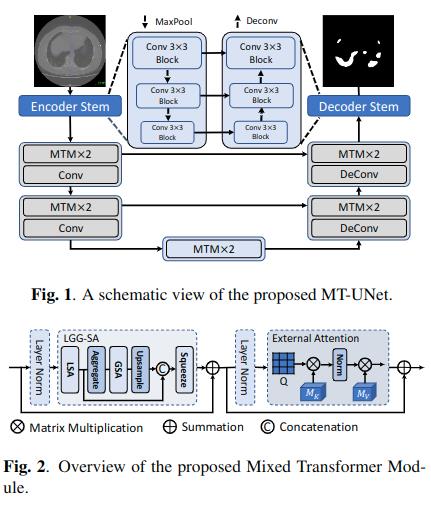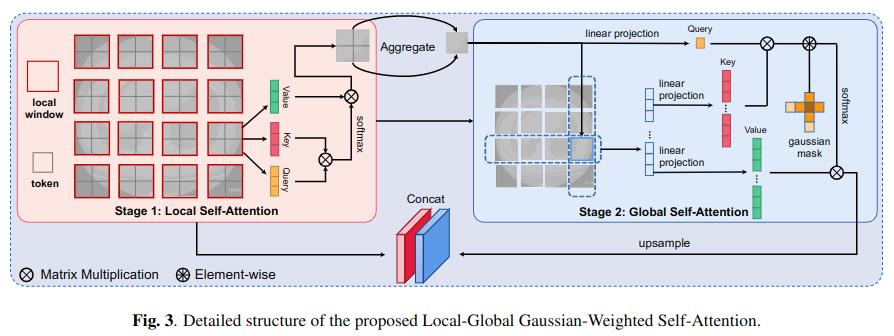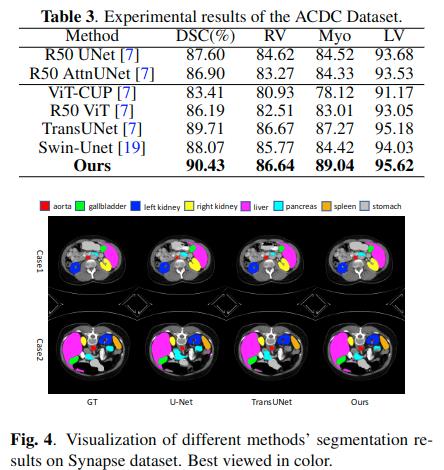恒源云(GpuShare)_医学图像分割:MT-UNet
Posted AI酱油君
tags:
篇首语:本文由小常识网(cha138.com)小编为大家整理,主要介绍了恒源云(GpuShare)_医学图像分割:MT-UNet相关的知识,希望对你有一定的参考价值。

我们社区有新的技术分享小伙伴啦🎉🎉🎉
热烈欢迎👏
作为一名合格的搬运工,我必须做点事情表达我的喜悦之情:搬运~搬运~立即搬运~
文章来源 | 恒源云社区
原文地址 | 新的混合Transformer模块(MTM)
原文作者 | 咚咚
摘要
| 存在问题 | 虽然U-Net在医学图像分割方面取得了巨大的成功,但它缺乏对长期依赖关系进行显式建模的能力。视觉Transformer由于其固有的通过自注意(SA)捕捉长程相关性的能力,近年来成为一种可替代的分割结构。 |
|---|---|
| 存在问题 | 然而,Transformer通常依赖于大规模的预训练,具有较高的计算复杂度。此外,SA只能在单个样本中建模self-affinities,忽略了整个数据集的潜在相关性 |
| 论文方法 | 提出了一种新的混合Transformer模块(MTM),用于同时进行inter-affinities学习和intra-affinities学习。MTM首先通过局部-全局高斯加权自注意(LGG-SA)有效地计算窗口内部affinities。然后,通过外部注意挖掘数据样本之间的联系。利用MTM算法,构造了一种用于医学图像分割的MT-UNet模型 |
Method

如图1所示。该网络基于编码器-解码器结构
- 为了降低计算成本,MTMs只对空间大小较小的深层使用,
- 浅层仍然使用经典的卷积运算。这是因为浅层主要关注局部信息,包含更多高分辨率的细节。
MTM
如图2所示。MTM主要由LGG-SA和EA组成。
LGG-SA用于对不同粒度的短期和长期依赖进行建模,而EA用于挖掘样本间的相关性。
该模块是为了替代原来的Transformer编码器,以提高其在视觉任务上的性能和降低时间复杂度
LGG-SA(Local-Global Gaussian-Weighted Self-Attention)
传统的SA模块对所有tokens赋予相同的关注度,而LGG -SA则不同,利用local-global自注意力和高斯mask使其可以更专注于邻近区域。实验证明,该方法可以提高模型的性能,节省计算资源。该模块的详细设计如图3所示

local-global自注意力
在计算机视觉中,邻近区域之间的相关性往往比遥远区域之间的相关性更重要,在计算注意图时,不需要为更远的区域花费相同的代价。
因此,提出local-global自注意力。
- 上图stage1中的每个局部窗口中含有四个token,local SA计算每个窗口内的内在affinities。
- 每个窗口中的token被aggregate聚合为一个全局token ,表示窗口的主要信息。对于聚合函数,轻量级动态卷积(Lightweight Dynamic convolution, LDConv)的性能最好。
- 在得到下采样的整个特征图后,可以以更少的开销执行global SA(上图stage2)。

其中
X
∈
R
H
×
W
×
C
X \\in R^H \\times W \\times C
X∈RH×W×C
其中,stage1中的局部窗口自注意力代码如下:
class WinAttention(nn.Module):
def __init__(self, configs, dim):
super(WinAttention, self).__init__()
self.window_size = configs["win_size"]
self.attention = Attention(dim, configs)
def forward(self, x):
b, n, c = x.shape
h, w = int(np.sqrt(n)), int(np.sqrt(n))
x = x.permute(0, 2, 1).contiguous().view(b, c, h, w)
if h % self.window_size != 0:
right_size = h + self.window_size - h % self.window_size
new_x = torch.zeros((b, c, right_size, right_size))
new_x[:, :, 0:x.shape[2], 0:x.shape[3]] = x[:]
new_x[:, :, x.shape[2]:,
x.shape[3]:] = x[:, :, (x.shape[2] - right_size):,
(x.shape[3] - right_size):]
x = new_x
b, c, h, w = x.shape
x = x.view(b, c, h // self.window_size, self.window_size,
w // self.window_size, self.window_size)
x = x.permute(0, 2, 4, 3, 5,
1).contiguous().view(b, h // self.window_size,
w // self.window_size,
self.window_size * self.window_size,
c).cuda()
x = self.attention(x) # (b, p, p, win, c) 对局部窗口内的tokens进行自注意力计算
return x
聚合函数代码如下
class DlightConv(nn.Module):
def __init__(self, dim, configs):
super(DlightConv, self).__init__()
self.linear = nn.Linear(dim, configs["win_size"] * configs["win_size"])
self.softmax = nn.Softmax(dim=-1)
def forward(self, x): # (b, p, p, win, c)
h = x
avg_x = torch.mean(x, dim=-2) # (b, p, p, c)
x_prob = self.softmax(self.linear(avg_x)) # (b, p, p, win)
x = torch.mul(h,
x_prob.unsqueeze(-1)) # (b, p, p, win, c)
x = torch.sum(x, dim=-2) # (b, p, p, c)
return x
Gaussian-Weighted Axial Attention
与使用原始SA的LSA不同,提出了高斯加权轴向注意(GWAA)的方法。GWAA通过一个可学习的高斯矩阵增强了相邻区域的感知全权重,同时由于具有轴向注意力而降低了时间复杂度。
- 上图中stage2中特征图的第三行第三列特征进行linear projection得到 q i , j q_i, j qi,j
- 将该特征点所在行和列的所有特征分别进行linear projection得到
K
i
,
j
K_i, j
Ki,j
和 V i , j V_i, j Vi,j - 将该特征点与所有的K和V的欧式距离定义为
D
i
,
j
D_i, j
Di,j
最终的高斯加权轴向注意力输出结果为

并简化为

轴向注意力代码如下:
class Attention(nn.Module):
def __init__(self, dim, configs, axial=False):
super(Attention, self).__init__()
self.axial = axial
self.dim = dim
self.num_head = configs["head"]
self.attention_head_size = int(self.dim / configs["head"])
self.all_head_size = self.num_head * self.attention_head_size
self.query_layer = nn.Linear(self.dim, self.all_head_size)
self.key_layer = nn.Linear(self.dim, self.all_head_size)
self.value_layer = nn.Linear(self.dim, self.all_head_size)
self.out = nn.Linear(self.dim, self.dim)
self.softmax = nn.Softmax(dim=-1)
def transpose_for_scores(self, x):
new_x_shape = x.size()[:-1] + (self.num_head, self.attention_head_size)
x = x.view(*new_x_shape)
return x
def forward(self, x):
# first row and col attention
if self.axial:
# x: (b, p, p, c)
# row attention (single head attention)
b, h, w, c = x.shape
mixed_query_layer = self.query_layer(x)
mixed_key_layer = self.key_layer(x)
mixed_value_layer = self.value_layer(x)
query_layer_x = mixed_query_layer.view(b * h, w, -1)
key_layer_x = mixed_key_layer.view(b * h, w, -1).transpose(-1, -2) # (b*h, -1, w)
attention_scores_x = torch.matmul(query_layer_x,
key_layer_x) # (b*h, w, w)
attention_scores_x = attention_scores_x.view(b, -1, w,
w) # (b, h, w, w)
# col attention (single head attention)
query_layer_y = mixed_query_layer.permute(0, 2, 1,
3).contiguous().view(
b * w, h, -1)
key_layer_y = mixed_key_layer.permute(
0, 2, 1, 3).contiguous().view(b * w, h, -1).transpose(-1, -2) # (b*w, -1, h)
attention_scores_y = torch.matmul(query_layer_y,
key_layer_y) # (b*w, h, h)
attention_scores_y = attention_scores_y.view(b, -1, h,
h) # (b, w, h, h)
return attention_scores_x, attention_scores_y, mixed_value_layer
else:
mixed_query_layer = self.query_layer(x)
mixed_key_layer = self.key_layer(x)
mixed_value_layer = self.value_layer(x)
query_layer = self.transpose_for_scores(mixed_query_layer).permute(
0, 1, 2, 4, 3, 5).contiguous() # (b, p, p, head, n, c)
key_layer = self.transpose_for_scores(mixed_key_layer).permute(
0, 1, 2, 4, 3, 5).contiguous()
value_layer = self.transpose_for_scores(mixed_value_layer).permute(
0, 1, 2, 4, 3, 5).contiguous()
attention_scores = torch.matmul(query_layer,
key_layer.transpose(-1, -2))
attention_scores = attention_scores / math.sqrt(
self.attention_head_size)
atten_probs = self.softmax(attention_scores)
context_layer = torch.matmul(
atten_probs, value_layer) # (b, p, p, head, win, h)
context_layer = context_layer.permute(0, 1, 2, 4, 3,
5).contiguous()
new_context_layer_shape = context_layer.size()[:-2] + (
self.all_head_size, )
context_layer = context_layer.view(*new_context_layer_shape)
attention_output = self.out(context_layer)
return attention_output
高斯加权代码如下:
class GaussianTrans(nn.Module):
def __init__(self):
super(GaussianTrans, self).__init__()
self.bias = nn.Parameter(-torch.abs(torch.randn(1)))
self.shift = nn.Parameter(torch.abs(torch.randn(1)))
self.softmax = nn.Softmax(dim=-1)
def forward(self, x):
x, atten_x_full, atten_y_full, value_full = x #x(b, h, w, c) atten_x_full(b, h, w, w) atten_y_full(b, w, h, h) value_full(b, h, w, c)
new_value_full = torch.zeros_like(value_full)
for r in range(x.shape[1]): # row
for c in range(x.shape[2]): # col
atten_x = atten_x_full[:, r, c, :] # (b, w)
atten_y = atten_y_full[:, c, r, :] # (b, h)
dis_x = torch.tensor([(h - c)**2 for h in range(x.shape[2])
]).cuda() # (b, w)
dis_y = torch.tensor([(w - r)**2 for w in range(x.shape[1])
]).cuda() # (b, h)
dis_x = -(self.shift * dis_x + self.bias).cuda()
dis_y = -(self.shift * dis_y + self.bias).cuda()
atten_x = self.softmax(dis_x + atten_x)
atten_y = self.softmax(dis_y + atten_y)
new_value_full[:, r, c, :] = torch.sum(
atten_x.unsqueeze(dim=-1) * value_full[:, r, :, :] +
atten_y.unsqueeze(dim=-1) * value_full[:, :, c, :],
dim=-2)
return new_value_full
local-global自注意力完整代码如下:
class CSAttention(nn.Module):
def __init__(self, dim, configs):
super(CSAttention, self).__init__()
self.win_atten = WinAttention(configs, dim)
self.dlightconv = DlightConv(dim, configs)
self.global_atten = Attention(dim, configs, axial=True)
self.gaussiantrans = GaussianTrans()
#self.conv = nn.Conv2d(dim, dim, 3, padding=1)
#self.maxpool = nn.MaxPool2d(2)
self.up = nn.UpsamplingBilinear2d(scale_factor=4)
self.queeze = nn.Conv2d(2 * dim, dim, 1)
def forward(self, x):
'''
:param x: size(b, n, c)
:return:
'''
origin_size = x.shape
_, origin_h, origin_w, _ = origin_size[0], int(np.sqrt(
origin_size[1])), int(np.sqrt(origin_size[1])), origin_size[2]
x = self.win_atten(x) # (b, p, p, win, c)
b, p, p, win, c = x.shape
h = x.view(b, p, p, int(np.sqrt(win)), int(np.sqrt(win)),
c).permute(0, 1, 3, 2, 4, 5).contiguous()
h = h.view(b, p * int(np.sqrt(win)), p * int(np.sqrt(win)),
c).permute(0, 3, 1, 2).contiguous() # (b, c, h, w)
x = self.dlightconv(x) # (b, p, p, c)
atten_x, atten_y, mixed_value = self.global_atten(
x) # (b, h, w, w) (b, w, h, h) (b, h, w, c)这里的h w就是p
gaussian_input = (x, atten_x, atten_y, mixed_value)
x = self.gaussiantrans(gaussian_input) # (b, h, w, c)
x = x.permute(0, 3, 1, 2).contiguous() # (b, c, h, w)
x = self.up(x)
x = self.queeze(torch.cat((x, h), dim=1)).permute(0, 2, 3,
1).contiguous()
x = x[:, :origin_h, :origin_w, :].contiguous()
x = x.view(b, -1, c)
return x
EA
外部注意(External Attention, EA),是用于解决SA无法利用不同输入数据样本之间关系的问题。
与使用每个样本自己的线性变换来计算注意分数的自我注意不同,在EA中,所有的数据样本共享两个记忆单元MK和MV(如图2所示),描述了整个数据集的最重要信息。
EA代码如下:
class MEAttention(nn.Module):
def __init__(self, dim, configs):
super(MEAttention, self).__init__()
self.num_heads = configs["head"]
self.coef = 4
self.query_liner = nn.Linear(dim, dim * self.coef)
self.num_heads = self.coef * self.num_heads
self.k = 256 // self.coef
self.linear_0 = nn.Linear(dim * self.coef // self.num_heads, self.k)
self.linear_1 = nn.Linear(self.k, dim * self.coef // self.num_heads)
self.proj = nn.Linear(dim * self.coef, dim)
def forward(self, x):
B, N, C = x.shape
x = self.query_liner(x) # (b, n, 4c)
x = x.view(B, N, self.num_heads, -1).permute(0, 2, 1,
3) # (b, h, n, 4c/h)
attn = self.linear_0(x) # (b, h, n, 256/4)
attn = attn.softmax(dim=-2) # (b, h, 256/4)
attn = attn / (1e-9 + attn.sum(dim=-1, keepdim=True)) # (b, h, 256/4)
x = self.linear_1(attn).permute(0, 2, 1, 3).reshape(B, N, -1)
x = self.proj(x)
return x
EXPERIMENTS



 创作打卡挑战赛
创作打卡挑战赛
 赢取流量/现金/CSDN周边激励大奖
赢取流量/现金/CSDN周边激励大奖
以上是关于恒源云(GpuShare)_医学图像分割:MT-UNet的主要内容,如果未能解决你的问题,请参考以下文章
恒源云(GpuShare)_MaskFormer:语义分割可以不全是像素级分类
恒源云(GpuShare)_MaskFormer:语义分割可以不全是像素级分类
恒源云 (Gpushare)_Restormer:用于高分辨率图像重建的高效Transformer